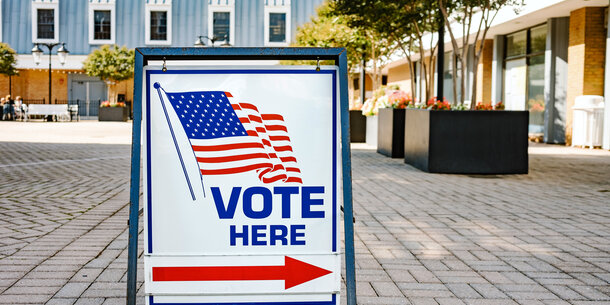Votes are still being counted, but turnout in this month’s election is expected to reach over 66 percent. That’s higher than it’s been since 1900, when President William McKinley was re-elected.
The chance to render a verdict on Donald Trump clearly drew out voters on both sides, but it isn’t the only reason for the surge. Also deserving credit is the broad-based movement that over the last five years has transformed access to voting in many states, both through policies that make it easier to cast a ballot, and through on-the-ground organizing drives. Put differently, in an election in which our democracy itself really was on the ballot, the democracy reform movement had a major impact — especially in pushing back against voter suppression targeting racial minorities.
Still, as we recognize that achievement, we also need to look forward. Having an administration in Washington that wants to expand, not restrict, voting and democracy — or even just one that doesn’t operate via a barrage of lies designed to undermine confidence in our elections — opens up a host of new opportunities. But as we look to build on this momentum, there are plenty of challenges lying ahead.
First, here’s why democracy advocates should be celebrating: A Bloomberg News model ranks states by how much their turnout increased this year compared to 2016. And several of the states that saw the biggest jumps expanded access to mail voting recently. Hawai’i, which saw a stunning increase of nearly 14 percentage points, the largest in the nation, passed a law in 2019 that ensured all registered voters were mailed a ballot. Two other states with big jumps, Montana, which saw the fourth largest increase, and Vermont (eighth), took the same step this year. South Carolina (tenth) and Michigan (11th) for the first time allowed no-excuse mail voting. Meanwhile, Georgia (sixth), Washington (seventh), Vermont, and Michigan had implemented automatic voter registration since 2016, transforming access to the voter rolls (Michigan also added same-day registration).
Although some of the vote-by-mail reforms came in response to the pandemic, it’s doubtful that many states, both red and blue, would have acted as quickly and aggressively as they did if a powerful pro-democracy movement hadn’t made clear in recent years that voters care passionately about protecting and expanding access to the polls.
One more point that stands out from Bloomberg’s data: It’s also likely not a coincidence that two top performers, Texas (fifth) and Georgia (sixth), saw well-funded and energetic grassroots campaigns — led by Beto O’Rourke and Stacey Abrams respectively — to register and mobilize new voters, especially minorities and the young.
The obvious conclusion from all this: Both policy changes that make voting easier and well-organized grassroots campaigns to bring new voters into the process are making a real difference in expanding the promise of democracy — even in a pandemic. We’re on the right track.
It also was a relief that online misinformation, though far from absent, appears to have played less of a role in deceiving voters than it did in 2016, when racial minorities were particular targets of this form of suppression. That was in part a result of steps taken by Facebook and Twitter to crack down on fake news — which came only after concerted pressure from advocates fighting for fair elections.
But this isn’t the time to relax. By endlessly repeating the lie that the election was stolen from him by illegal voting, President Trump has likely cemented the false view of a large chunk of his supporters that fraud is a significant problem, especially for vote-by-mail. That could make it harder to keep expanding access, for instance by making no-excuse vote-by-mail a permanent policy, not just a temporary response to the pandemic. In some states, it could even serve to rally support for harmful new restrictions. Indeed, some Republicans, aware that those who voted by mail this year were disproportionately Democrats, are already talking about how to prevent it from becoming normalized.
“Mitch McConnell and I need to come up with an oversight of mail-in balloting,” Sen. Lindsey Graham, a staunch Trump ally, said on Fox News soon after the election. “If we don’t do something about voting by mail, we are going to lose the ability to elect a Republican in this country.”
Another big challenge will come on redistricting, whose next cycle begins in 2021. True, a combination of voter-approved redistricting reforms, positive court rulings and Democratic gains since 2010 should mean that we see modest improvements in some of the states that saw the most extreme gerrymanders last time. But that’s a low bar. In this month’s elections, Democrats tried but failed to flip state legislative chambers in Texas, North Carolina, and Georgia, meaning Republicans will retain sole control of the process in those states, as well as in Florida and Missouri, among others.
And here, an even larger threat looms: that the Supreme Court could strike down independent redistricting commissions — the most promising reform solution out there — because they exclude the legislature from the process, as several of the justices want to do. If that were to happen, commissions like the one Virginia voters just approved this month, which do include a role for the legislature along with ordinary citizens, could become a model for at least some other states.
For now, though, we should take pride in the reality that, despite numerous serious challenges, the U.S. ultimately pulled off an election that was not only free and fair, but vibrant and sometimes even joyful, and in which more people than ever participated. And that was thanks in part to those who for years have been fighting to make it happen.
The views expressed are the author’s own and not necessarily those of the Brennan Center.



